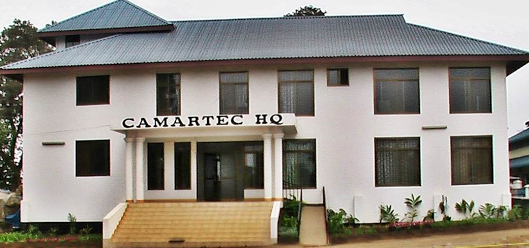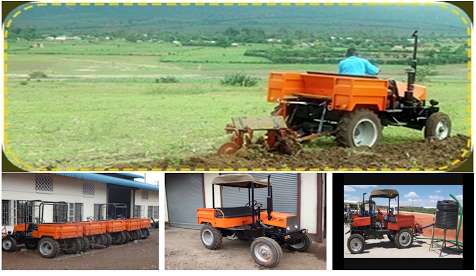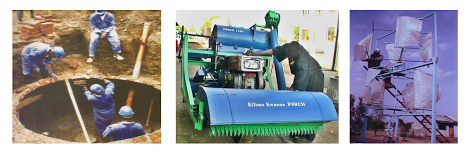CAMARTEC is one of those Tanzanian organizations that immediately captured my attention as soon as I heard about in 2013, in my first visit to Tanzania. Eventually I was able to visit its headquarters, in Arusha, and meet and speak some of its staff who, over time, became friends and acquaintances. They showed me around the place (the workshops, the exhibition of products, the offices and departments, and the in-house bio-gas project). Over time, I grew to appreciate what CAMARTEC represents – the idea and the potential – because it epitomizes a very direct and practical response to pressing challenges on the front of technological change for rural and agricultural development, not only in Tanzania, but in East Africa in general, in my opinion .

A brief introduction:
CAMARTEC is the acronym for ‘Centre for Agricultural Mechanization and Rural Technology’. Established by the ministry of industry, CMARTEC’s mission is to function as an innovation centre for testing and building agricultural machinery and rural technology. CAMARTEC has the mandate of disseminating improved technologies for agricultural and rural development. It also has the mandate of supporting small enterprises that are embarking on innovating and marketing agricultural or rural technological products. The main goal of CAMARTEC is to boost agricultural production and improve the quality of life of rural Tanzanians. CAMARTEC carries out and promotes applied research designated to facilitate the designing, adoption and development of machinery and equipment suitable for local use. Their list of technological projects stretches as wide as follows:
- locally made multi-purpose tractors,
- biogas energy production plants (small to medium sizes),
- multiple agricultural plug-in machines to power tillers (such as grain threshers, maize shellers, and ploughs),
- solar cookers and fruit/vegetable solar dryers,
- building-block makers and affordable cooking stoves.

CAMARTEC encourages small and middle-sized enterprises to uptake, market and mass-produce the technologies that it develops, in a for-profit model for those enterprises. Since CAMARTEC itself is not in the business of mass-production – rather applied technology research and development – that makes it a natural ally of SEs and an important agent of technology diffusion. Also, as a government-funded institute, CAMARTEC is a good representative of national Tanzanian policy for technological development. CAMARTEC basically represents one frontier of the Tanzanian government’s support for small enterprises that can serve as agents for agricultural and rural technological development. Along with other organizations, such as SIDO (Small Industries Development Organization), these government representatives play a critical role in the technology diffusion process, in which other actors as well are involved.
The significance of CAMARTEC’s approach:
I spoke about my visit to STIPRO (Science, Technology & Innovation Policy Research Organization) on a previous article.[1] In that article I also spoke about an important policy conclusion that STIPRO promotes with regards to the wiser and more efficient approaches to the promotion of industrial development (technology and innovation) in developing countries. That approach was best articulated by a STIPRO policy brief. In developing countries that are trying to achieve a sufficient level of technology autonomy, there are a number of leading examples that demonstrate that,
“Innovation is achieved through tinkering or learning by doing; and where R&D is used, it is to assist in the tinkering; and in most cases has to be close to production, e.g R&D units in companies. Example of Japan is instructive here. Japan for instance started industrialization through import of foreign technology, integrated this into R&D and production departments. The Japanese R&D during this era, termed as catching up period (1945-1972) was largely on adaptive technology.”[2]
Knowing CAMARTEC’s vision and mandate, and looking at its actual activities, one can see that it is a good example of that policy approach – taking calculated path towards technology autonomy. This is confirmed by the fact that COSTECH (Tanzania Commission for Science and Technology), the parastatal institution in charge with coordinating the activities and plans of organizations like CAMARTEC and SIDO, overtly states its commitment to technology autonomy. the Centre for Development and Transfer of Technology (CDTT), a department within COSTECH, defines technology autonomy as the capacity “to create […] an enabling environment [for] making independent and correct decisions on the choice of technology, its evaluation, and internalization, generation of endogenous capacity for adaptation, innovation and development of sustainable technologies.”[3]

When I look at CAMARTEC, I involuntarily remember a contrast example that I once encountered through watching the BBC documentary series The Africans: A triple heritage, prepared and hosted by the late Dr. Ali Mazrui.[4] In part 4 of the series, Mazrui takes the viewers through big, state-of-the-art industrial factories in two West African countries. Those factories were built right after political independence was achieved, and they were built from the ground-up on the budget the state. They were built to represent a proud leap forward by the newly independent countries towards the era of modernization. One thing was missing, however, from the floors of those factories: namely people and products. They were decommissioned plants, that lasted for only short periods of time before their state governments realized they were running at a cost higher than their return, with no foreseen change in that situation in the near future. Being high-tech plants, they were not only commissioned and built by Western corporations; they were also operated by them. They were foreign plants on African soil, and they were not able to serve the development priorities of their host countries. In the end a tough lesson was learned (hopefully) the hard way. Institutions like CAMARTEC reminded me of that story because it represents the other side; the antidote to that story. In any case, it represents that antidote at least in theory.
Observations and challenges:
On a personal level I was impressed by the skills and creativity of some of the engineers I met in CAMARTEC. They get to be in an environment that offers them room for tinkering and picking their innovative sides. Also in CAMARTEC exist agricultural scientists, statisticians, legal and administrative professionals, and of course many workshop technicians, in addition trainee students, all interacting with each other to keep things happening; just the kind of diversity of staff and specialties a proper R&D institution needs. The workshops have on-going projects, finished prototypes, simple models of initial ideas, next to multiple fabrication machinery and raw materials. An overall industrious and friendly environment; the kind that is very attractive for people like me.
That said, it will be only fair now to briefly mention some of the challenges that CAMARTEC faces and makes its work go less smoothly than expected. For once, it is fairly clear that the organization is heavily debilitated by two major constraints:
- Financial constraints: not a surprise, being a state-funded institution in a developing country, its funding is always subject to political evaluation by the government leadership. In their turn, the government leadership deals with a challenged budget to respond to a large number of problems typical of developing societies and also problems unique to Tanzania as well. One cannot expect but limited funding that goes to R&D activities that are not deemed of immediate importance in such conditions.
- Regulative constraints: being commissioned only as an R&D institution, CAMARTEC is not capable, by law, to uptake any of its own produced/innovated products to mass production and marketing. In other words, it is not allowed to engage in commercial activities. Once some design prototypes are finalized, tested and proved to be ready for productive use, CAMARTEC could only hope that another entity capable of taking the product to mass production and marketing shows up and shows interest in its products (private enterprise, capable NGO, state corporation, well-funded start-up, etc.). With fewer resources available for promotion of its products, not many outside CAMARTEC get to hear about the competent prototypes made there, and even less will be interested enough to consider taking the risk with new, locally made products, especially if there are any similar ‘foreign’ products they seem to trust more due to brand name or country of origin.

There are of course more challenges than the two above, but one can safely conclude that the two above are the one with the biggest impact, since they are persistent and also structural (i.e. no just circumstantial). But since the main challenges are visible and easy to detect, that also means that how to resolve them is not a big mystery. Once enough political will is there, both regulations and finances can be re-assessed as wise investments in such national projects of long-lasting benefits. Plenty of historical evidence can be used to show that investing in local industries, and protecting them in their infancy against international competition, reaps good fruits in the future of the countries that take that path. All in all, there is room for hope that these constraints can change in the near future, and an institution like CAMARTEC will be able its full role in the process of agricultural and rural development.
———
[1] See previous blog on STIPRO
[2] STIPRO (2010). “The Utility Value of Research and Development (R&D): Where does Tanzania Stand?”. Policy Brief.
[3] Retrieved on August 15, 2013, from: http://www.costech.or.tz/?page_id=1657
[4] Mazrui, Ali Al’Amin (1986). “Tools of Exploitation.” Part 4 of The Africans: A Triple Heritage. a BBC documentary series.

That was an insightful coverage.
This is a great work CAMARTEC for people of Tanzania and East Africa at large.Continue to come up with great work inventions.